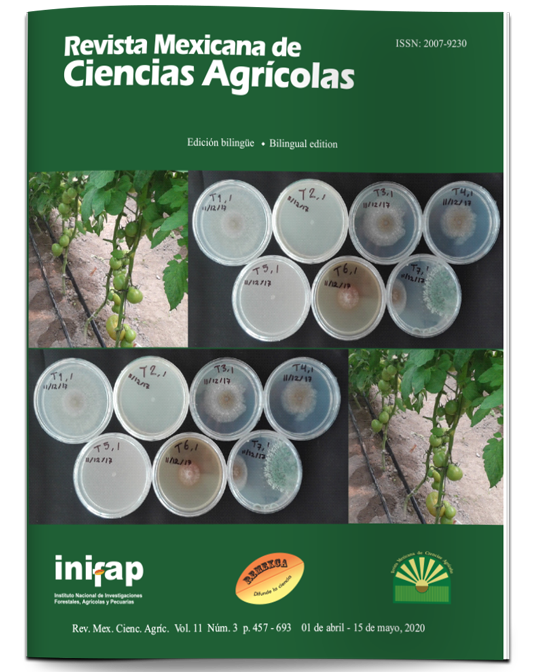Water quality for agricultural use of the San Pedro River, Nayarit
DOI:
https://doi.org/10.29312/remexca.v11i3.2083Keywords:
adjusted RAS, hydrogeochemistry, saturation indexAbstract
The study area is of fluvian delta formation, with a predominance of cambisol and fluvisole soils. The main crops in the area are beans, corn, sorghum, tobacco and tomatillo. These are watered with water from the San Pedro River. Surface water, when it contains high concentrations of sodium or bicarbonate, can cause adverse effects in agriculture. With the objective of evaluating these effects, nine sampling sites were established in the riverbed and four samplings were carried out over a period of two years, in a rainy and dry season each year. The pH, EC, anions and major cations were determined, the hydrogeochemical type was established and the RAS, RASº, RASaj, PSI, CSR and the saturation index were calculated. In the section of the river from El Rosarito to El Mezcal, the water is bicarbonated sodium-calcium-magnesium and from Mexcaltitan to Boca de Camichin, it was chlorinated-sodium. The RAS in its different conceptualizations for the first section were from 0.38 to 1.58, the EC ranged between 131-367 μS cm-1 and the PSI<3%; while, for the last section, the RAS varied between 9.06-161.16, the EC between 2 350-4 3130 μS cm-1 and the PSI between 6.16-73.14%. The waters from the San Pedro de El Rosario to El Mezcal river turned out to be excellent to good quality. Chlorinated-sodium waters are not suitable for agricultural use.
Downloads
Published
How to Cite
Issue
Section
License
The authors who publish in Revista Mexicana de Ciencias Agrícolas accept the following conditions:
In accordance with copyright laws, Revista Mexicana de Ciencias Agrícolas recognizes and respects the authors’ moral right and ownership of property rights which will be transferred to the journal for dissemination in open access. Invariably, all the authors have to sign a letter of transfer of property rights and of originality of the article to Instituto Nacional de Investigaciones Forestales, Agrícolas y Pecuarias (INIFAP) [National Institute of Forestry, Agricultural and Livestock Research]. The author(s) must pay a fee for the reception of articles before proceeding to editorial review.
All the texts published by Revista Mexicana de Ciencias Agrícolas —with no exception— are distributed under a Creative Commons License Attribution-NonCommercial 4.0 International (CC BY-NC 4.0), which allows third parties to use the publication as long as the work’s authorship and its first publication in this journal are mentioned.
The author(s) can enter into independent and additional contractual agreements for the nonexclusive distribution of the version of the article published in Revista Mexicana de Ciencias Agrícolas (for example include it into an institutional repository or publish it in a book) as long as it is clearly and explicitly indicated that the work was published for the first time in Revista Mexicana de Ciencias Agrícolas.
For all the above, the authors shall send the Letter-transfer of Property Rights for the first publication duly filled in and signed by the author(s). This form must be sent as a PDF file to: revista_atm@yahoo.com.mx; cienciasagricola@inifap.gob.mx; remexca2017@gmail.
This work is licensed under a Creative Commons Attribution-Noncommercial 4.0 International license.



